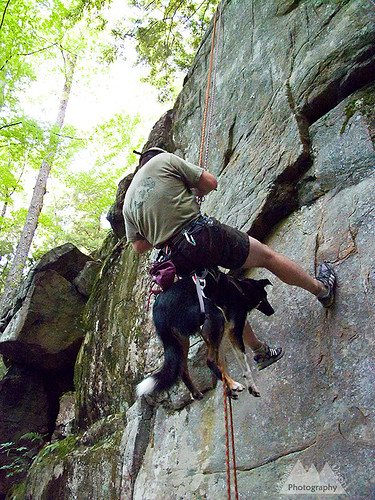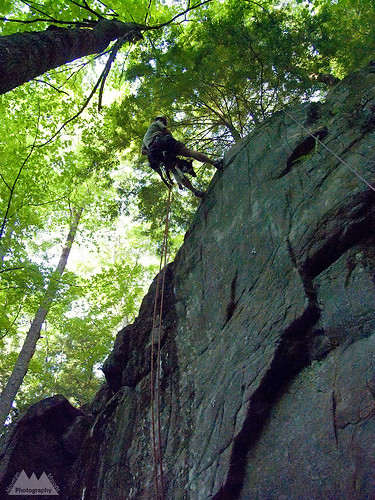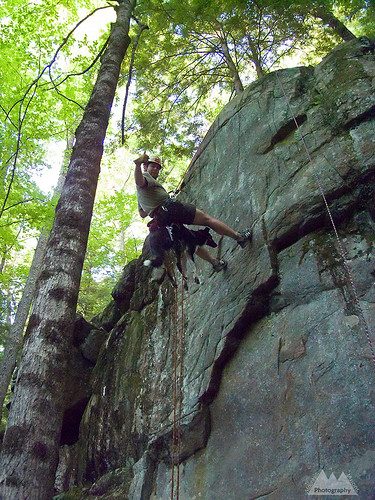
Scared shitless, that would be a good way to describe this. Of course, you are thinking, why the hell would you torment your dog. No, I was scared shitless. Looking down at my harness was a clusterfuck (a climbing term for a mess or log jam) of epic proportions. The only other time my belay loop/tie in point has ever been that busy was while aid climbing. The big difference between this and aiding, Colvin isn't aiders or a haul bag.
I'd planned this day for a while, starting back last Autumn when I re-purchased the Ruffwear Doubleback technical harness. Petzl used to make such a harness, for a fair price at that, then one day they stopped. A fairly recent addition to the Ruff Wear catalog, the Doubleback is the only harness not designed specifically for the needs of search and rescue or SWAT dogs. It's designed to be worn at all times, with hide-away leg loops and a strength rated tie-in point. It's basically a recreational climbing harness for your dog. In theory you could use it as a standard trail harness, but the chest pad and need to "double back" the threaded straps would make it highly inconvenient, and possibly uncomfortable for the dog. Colvin wears his only when I think I might need to rope or haul him.
We used the harness a few times this winter on semi technical terrain, and also hoisted Colvin in it to test the fit and rigging. Outdoors we used it in the Northern Presidential's, on terrain that is often underestimated by novice mountaineers and experienced hikers alike. If the terrain calls for an ice axe and crampons, roping the dog should be a serious consideration. While SAR comes out pretty quickly for humans, I'd prefer not to find out they won't come to rescue a dog. So being extra cautious is important. With this in mind, I practiced short rope techniques with Colvin on a short rope belay. The short rope wasn't really needed due to the conditions not being as snow covered as potentially possible. Still, it was good opportunity to test and refine a technique for more technical terrain when necessary.
I'd taken Caney, my previous trail dog, on the North-South Arapaho traverse (class 3-4/5.0) and up and down various glaciated peaks via snow climbs and scrambles around Lake Isabelle and Triangle Lake in the Indian Peaks; on Central Gully on Mount Washington (WI2, mostly snow), and on various slides, slabs and 4th class scrambles in the Adirondacks. So I know these dogs are capable of going places many choose not to take a dog, but I also know this all comes with a greater responsibility on me. Not only am I responsible for myself, I am also responsible for the dog on very challenging terrain. Practicing under controlled circumstances is the best way to assure everyone is safe.
My ideal test place for our first rappel was someplace quiet, secluded, without other climbers. Also preferred was a slightly overhanging face or a free hanging rappel, with high fixed or natural anchors at the top. The Gunks would have done the rock portion of my requirements quite nicely but finding solitude isn't always easy. There was a good chance Colvin would be squeaking and squealing, which he did, as we went over the lip of the cliff. The last thing I wanted to deal with was the cacophony of beta spewing climbers giving unhelpful advice.

Though not well known nationally -due to being in the shadow of the Gunks- the Adirondacks have an immense amount of high quality technical rock climbing routes. And unless you seek out a crowd (the High Peaks roadside options), you will rarely climb with other people. 2,000 routes on 260 separate climbing areas 82 of which offer multi pitch climbing, all spread out over nearly 4 million acres of public land. For this project, Carl's New Baby, a bolted 5.10b on the Hudson River was just perfect.
 |
| Petzl Stop. Image: Petzl.com |
Safety came in the form of 2 independent but equalized tree anchors about 5 feet from the cliff edge. There was nice clean rock before and over the lip. Aim backed up the first rappel with a top-rope belay topside. The second two rappels she only belayed me over the lip, where the best chance of something going wrong was. In the future I'd probably use a Petzl Gri-Gri, a Petzl Rappel Rack, or perhaps best, a Petzl Stop descender. If nothing else I'd add a carabiner to increase friction.
 |
| Petz Rack. Image: Petzl.com |
Nevertheless, it took me a while to get everything to where I wanted it, or rather was comfortable with it. Not only was it about being safe, but also making the rappel as comfortable and smooth as possible for Colvin. A bad experience the first time could have left him unwilling to do it again.
Looking at all the anchors (3 in total, two ropes, multiple attachments) it was beginning to look overwhelming. After double, triple, and finally, quadruple checking everything I just said it, "I'm pretty nervous, my heart is pounding." A dog can sense your level of anxiety, and I was hoping to not have been that nervous. Colvin was already attached to my harness, I lifted him up and carried him to the edge, leaned back on my anchor and we were rappelling.
Once the instinct to grab the cliff for dear life was exhausted, Colvin, as with most dogs, gave up and became very calm and still. No squealing, no whimpering, no barking, and no flailing. I'm not sure he was relaxed, it's more a submission than anything, but my anxiety was gone after a few feet of descent.
During the first rappel, Colvin was attached directly by a single locking biner to my belay loop. I've seen this method used by SWAT and fast rope teams, however, he didn't hang far enough down and removing him from the harness was difficult once we touched down. I'd say this method would be better, if I went directly through my rappel biner while on lower angle terrain. Keeping him high on low angle terrain would keep him from bouncing into the rock.
For the second rappel, I used a tripled shoulder length alpine draw, with lockers on both ends to attach Colvin to my harness. I stabilized his rear leg loops with a 4 foot sling that I shortened. The rear loop tie-in isn't required and it's not truly a functional tie-in. What I mean is that it doesn't enhance safety, it's about comfort. This setup worked pretty well and it seemed like he was in near perfect position, perhaps a few inches lower would have been ideal.
By the third rappel, I was having fun. The anxiety was gone, Colvin was doing awesome, and the setup was just about perfectly refined. Again, I had Aim belay us but just while we were getting setup on the edge. Once we were on the rappel rope and anchor, she was free to take the belay off and snap a few photos.
Aside from not having time to actually climb, it was a hell of a day.

















No comments:
Post a Comment